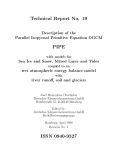Download Nonthermal Module User`s Manual
Transcript
Nonthermal Module User's Manual John C. Houck, [email protected] Apr 1, 2010 2 Contents 1 Introduction 5 2 Examples 7 2.1 X-ray Synchrotron Emission . . . . . . . . . . . . . . . . . . . . . . . . . . . . . . . . 7 2.2 Inverse-Compton Gamma-ray Emission 8 3 Spectral Models 3.1 sync . . . . . 3.2 invc . . . . . 3.3 ntbrem . . . 3.4 pizero . . . . . . . . . . . . . . . . . . . . . . . . . . . . . 11 . . . . . . . . . . . . . . . . . . . . . . . . . . . . . . . . . . . . . . . . 11 . . . . . . . . . . . . . . . . . . . . . . . . . . . . . . . . . . . . . . . . 12 . . . . . . . . . . . . . . . . . . . . . . . . . . . . . . . . . . . . . . . . 13 . . . . . . . . . . . . . . . . . . . . . . . . . . . . . . . . . . . . . . . . 14 4 Built-In Particle Distribution Functions 4.1 default . . . . . . . . . . . . . . . . . . 4.2 cbreak . . . . . . . . . . . . . . . . . . 4.3 ke_cuto . . . . . . . . . . . . . . . . 4.4 etot . . . . . . . . . . . . . . . . . . . . 4.5 dermer . . . . . . . . . . . . . . . . . . 4.6 mori . . . . . . . . . . . . . . . . . . . . 4.7 boltz . . . . . . . . . . . . . . . . . . . 4.8 rboltz . . . . . . . . . . . . . . . . . . . 4.9 full1 . . . . . . . . . . . . . . . . . . . . 17 . . . . . . . . . . . . . . . . . . . . . . . . . 17 . . . . . . . . . . . . . . . . . . . . . . . . . 18 . . . . . . . . . . . . . . . . . . . . . . . . . 18 . . . . . . . . . . . . . . . . . . . . . . . . . 19 . . . . . . . . . . . . . . . . . . . . . . . . . 19 . . . . . . . . . . . . . . . . . . . . . . . . . 19 . . . . . . . . . . . . . . . . . . . . . . . . . 20 . . . . . . . . . . . . . . . . . . . . . . . . . 20 . . . . . . . . . . . . . . . . . . . . . . . . . 20 5 User-Dened Particle Distribution Functions 23 6 Utility Functions 6.1 add_pdf . . . . . . 6.2 make_sync_table 25 . . . . . . . . . . . . . . . . . . . . . . . . . . . . . . . . . . . . 25 . . . . . . . . . . . . . . . . . . . . . . . . . . . . . . . . . . . . 25 3 CONTENTS 4 6.3 6.4 6.5 6.6 6.7 6.8 6.9 6.10 6.11 6.12 6.13 6.14 6.15 make_invc_table . . . . . . make_ntbrem_table . . . . ntb_set_process_weights . particle_info_struct . . . . nd_momentum_min . . . nontherm_density . . . . . . nontherm_energy_density force_charge_conservation _sync_angular_integral . . _invc_photon_integral . . _ee_haug1 . . . . . . . . . . _ee_haug1_lab . . . . . . . _ep_heitler1 . . . . . . . . . . . . . . . . . . . . . . . . . . . . . . . . . . . . . . . 26 . . . . . . . . . . . . . . . . . . . . . . . . . . . . . . 26 . . . . . . . . . . . . . . . . . . . . . . . . . . . . . . 27 . . . . . . . . . . . . . . . . . . . . . . . . . . . . . . 27 . . . . . . . . . . . . . . . . . . . . . . . . . . . . . . 28 . . . . . . . . . . . . . . . . . . . . . . . . . . . . . . 28 . . . . . . . . . . . . . . . . . . . . . . . . . . . . . . 29 . . . . . . . . . . . . . . . . . . . . . . . . . . . . . . 29 . . . . . . . . . . . . . . . . . . . . . . . . . . . . . . 29 . . . . . . . . . . . . . . . . . . . . . . . . . . . . . . 30 . . . . . . . . . . . . . . . . . . . . . . . . . . . . . . 30 . . . . . . . . . . . . . . . . . . . . . . . . . . . . . . 31 . . . . . . . . . . . . . . . . . . . . . . . . . . . . . . 31 Chapter 1 Introduction As part of our work on cosmic-ray acceleration in supernova remnants, we wanted to search for evidence of curvature in relativistic particle momentum distributions. However, to the best of our knowledge, no publically-available spectral-tting package included models for photon emission generated by relativistic particles (via synchrotron, inverse Compton, nonthermal bremsstrahlung and neutral-pion decay processes) and also allowed one to easily investigate the eect of dierent particle distribution functions. XSPEC includes the synchrotron models SRCUT and SRESC, but these models are based on a xed particle distribution function parameterization. By implementing the necessary spectral models in a form accessible to the ISIS spectral analysis system, we gain the ability to t these models not just to X-ray data, but also to radio and gammaray observations as well. By simultaneously tting observations from several wave-bands, one can try to better constrain the important t parameters. This manual describes each of the spectral models and particle distribution functions and also provides a few simple usage examples. The physical assumptions used to create the models and various computational details are discussed in Houck & Allen (2006) [ApJS, 167, 26]. 5 6 Chapter 1. Introduction Chapter 2 Examples In the following examples, we assume that the nonthermal module has been installed in the default location so that isis will nd it automatically. 2.1 X-ray Synchrotron Emission In this section, we describe how to t X-ray data using the synchrotron model. For a more general discussion of how to use isis in data analysis, see the ISIS documentation http://space.mit.edu/ cxc/isis/manual.html . First, import the nonthermal module using require ("nonthermal"); to make the spectral models and related functions available to isis. Next, load the spectral data, background spectrum and instrument responses: variable pha = load_data ("pha.fits"); assign_arf (load_arf ("arf.fits"), pha); assign_rmf (load_rmf ("rmf.fits"), pha); () = define_bgd (pha, "back.fits"); At this point, it may be desirable to rebin the data to improve the count-statistics in certain regions and to ignore selected spectral intervals. For example, to ensure that each bin contains at least 25 counts, use rebin_data (pha, 25); and, to t only data in the range 2-8 keV, use xnotice_en (pha, 2, 8); Next, dene the spectral model. For this example, we will use a simple model consisting of a single synchrotron emission component modied by line of sight absorption. To compute the synchrotron 7 Chapter 2. Examples 8 emission spectrum, it is necessary to specify the underlying particle momentum distribution function. For this example, we will use the default momentum distribution function described in Houck & Allen (2006) [ApJS, 167, 26]. To model the eects of line of sight absorption, we will use the phabs function from XSPEC. The spectral model is then: fit_fun ("phabs(1) * sync(1, default(1))"); Before tting the data, is usually a good idea to choose initial parameter values such that the starting model is reasonably close to the data. Once we're satised with the initial parameter values, perform the t and then overplot the model and data histograms: () = fit_counts; rplot_counts (pha); At this point, it is usually a good idea to investigate the neighborhood of the tted parameters to make sure that the best possible t has been achieved. For example, we might use conf to compute single parameter condence limits for t-parameters of interest. 2.2 Inverse-Compton Gamma-ray Emission The process of tting gamma-ray data is essentially identical to that used to t X-ray data in the previous example. The primary dierence is that, before the data can be loaded into isis, TeV gamma-ray spectra must rst be cast into a suitable form. One suitable form is an ASCII le with spectral data in four columns and with a small number of scalar parameters specied using header keywords. Using HEGRA observations of Cas A as a concrete example, we might create a le that looks like this: # ; ; ; ; # flux in photons/s/cm^2/bin object Cas A bintype counts xunit TeV exposure 1.0 E_lo E_hi 4.997493e-01 7.913994e-01 7.913994e-01 1.256344e+00 1.256344e+00 1.992807e+00 1.992807e+00 3.168774e+00 3.168774e+00 4.997493e+00 4.997493e+00 7.913994e+00 7.913994e+00 1.258409e+01 1.258409e+01 2.001003e+01 flux 2.839012e-12 3.729176e-13 1.503555e-13 7.704922e-14 4.837415e-14 1.115603e-14 1.821113e-14 1.804125e-15 error 1.783329e-12 2.399393e-13 7.308948e-14 3.311765e-14 1.612472e-14 1.247306e-14 1.224027e-14 3.373713e-15 Details of this format are described in the ISIS documentation . Lines beginning with a '#' symbol are ignored and may be used to insert comments. The rst two columns dene the lower and upper edges of histogram bins. The bins must be in monotonic increasing order and may not overlap. The 'xunit' keyword species the 2.2. Inverse-Compton Gamma-ray Emission 9 bin coordinate units; in this case, the bin coordinates give the photon energy in TeV. The next two columns contain the ux in photons/s/cm2 and the associated uncertainty, assumed to be symmetric. Lines beginning with a semicolon (;) dene various keywords recognized by isis. The exposure keyword species a nominal exposure time of one second. Note that the 'bintype' keyword labels the data as counts even though the spectral values are given in ux units. This subterfuge allows us to simultaneously t X-ray data (in counts) and gammaray data (in ux units). However, to make this work, we must remember to turn o one of the normal data-input validation tests. By default, when isis reads counts spectra, it requires that the uncertainty in the number of counts be greater than or equal to one. If the input data do not satisfy this requirement, isis replaces the relevant input uncertainties with acceptable values. To keep isis from modifying our input uncertainties in this way, we set the intrinsic variable Minimum_Stat_Err to a small positive value (smaller than any of the input uncertainties). Having converted the Cas A HEGRA spectrum into the above format, we can load the data into isis: Minimum_Stat_Err = 1.e-30; variable id = load_data ("casa_hegra_data.txt"); Once the data have been loaded, we can dene and t a model exactly as before. For example, to t a model which includes both inverse Compton and neutral-pion decay components, we can use fit_fun ("invc(1, default(1)) + pizero(1, default(2))"); Note that two particle distribution functions appear in this spectral model. The inverse Compton component uses default(1) to dene the electron momentum distribution and the neutral-pion decay component uses default(2) to dene the proton momentum distribution. 10 Chapter 2. Examples Chapter 3 Spectral Models Note on dierential vs. histogram forms Dierential and histogram forms of each spectral model are provided. The histogram form is the one used in tting models to data. For this reason, input data must be converted to histogram form. The dierential form is normally used for testing and for making plots. See the ISIS documentation for additional details. 3.1 sync Synopsis Synchrotron spectrum model Usage sync(Int_Type i, String_Type pdf_name, Double_Type pdf_params[]) Description The sync function computes the synchrotron spectrum for a specied nonthermal particle distribution function. The synchrotron spectrum parameters are B_tot = total magnetic field strength [microgauss]. norm = normalization = A_e V / (4 \pi d^2) where A_e = nonthermal electron density at 1 GeV [cm^-3 GeV^-1] V = emitting volume [cm^3] d = distance [cm] The rst argument of the sync function is an integer index identifying a particular instance of this t function. The second and third arguments specify the particle distribution function (PDF) and its parameters. Normally, the second and third arguments are provided as return values by a special t-function that acts as an interface to the desired PDF. For example, 11 Chapter 3. Spectral Models 12 fit_fun ("sync(1, default(1))") causes the synchrotron function calculation to use the PDF named default, which has parameters index = momentum power-law index curvature = amount of curvature above 1 GeV E_cutoff = cut-off momentum [TeV]. When this t-function is evaluated, default(1) returns second and third parameters needed by sync. By default, the value of the angular integral is determined via spline interpolation in a precomputed table. To compute the angular integral value via direct integration, set the intrinsic variable _sync_interpolate to a non-zero value. See Also 6.11 (_sync_angular_integral) 3.2 invc Synopsis Inverse Compton spectrum model Usage invc(Int_Type i, String_Type pdf_name, Double_Type pdf_params[]) Description The invc function computes the inverse Compton spectrum for a specied nonthermal particle distribution function. The inverse Compton spectrum parameters are T_photon = radiation field temperature [K] norm = normalization = A_e V / (4 \pi d^2) where A_e = nonthermal electron density at 1 GeV [cm^-3 GeV^-1] V = emitting volume [cm^3] d = distance [cm] The rst argument of the invc function is an integer index identifying a particular instance of this t function. The second and third arguments specify the particle distribution function (PDF) and its parameters. Normally, the second and third arguments are provided as return values by a special t-function that acts as an interface to the desired PDF. For example, fit_fun ("invc(1, default(1))") causes the inverse Compton function calculation to use the PDF named default, which has parameters 3.3. ntbrem 13 index = momentum power-law index curvature = amount of curvature above 1 GeV E_cutoff = cut-off momentum [TeV]. When this t-function is evaluated, default(1) returns second and third parameters needed by invc. By default, the value of the integral over incident photon energies is determined via spline interpolation in a pre-computed table and the value of the T_photon parameter is not used. To compute this integral via direct integration, set the intrinsic variable _invc_interpolate to a non-zero value. See Also 6.12 (_invc_photon_integral) 3.3 ntbrem Synopsis Nonthermal bremsstrahlung spectrum model Usage ntbrem(Int_Type i, String_Type pdf_name, Double_Type pdf_params[]) Description The ntbrem function computes the nonthermal bremsstrahlung spectrum for a specied nonthermal particle distribution function, assuming a stationary target. The primary nonthermal bremsstrahlung spectrum parameter is the normalization, norm = n_t A_e V / (4 \pi d^2) where n_t A_e V d = = = = density of target nuclei [cm^-3] nonthermal electron density at 1 GeV [cm^-3 GeV^-1] emitting volume [cm^3] distance [cm] The rst argument of the ntbrem function is an integer index identifying a particular instance of this t function. The second and third arguments specify the particle distribution function (PDF) and its parameters. Normally, the second and third arguments are provided as return values by a special t-function that acts as an interface to the desired PDF. For example, fit_fun ("ntbrem(1, default(1))") causes the nonthermal bremsstrahlung function calculation to use the PDF named default, which has parameters index = momentum power-law index curvature = amount of curvature above 1 GeV E_cutoff = cut-off momentum [TeV]. Chapter 3. Spectral Models 14 When this t-function is evaluated, default(1) returns second and third parameters needed by ntbrem. By default, the value of the electron-electron dierential cross-section is determined via spline interpolation in a pre-computed table. To compute these cross-sections without interpolation, set the intrinsic variable _ntbrem_interpolate to a non-zero value. The relative contributions of electron-electron and electron-proton bremsstrahlung are controlled by the ntb_set_process_weights function. To use an alternate, somewhat faster, numerical integration algorithm, set the integer intrinsic variable _ntbrem_integration_method to a non-zero value. Note that changing the numerical integration method will cause small changes in the computed model values. See Also 6.5 (ntb_set_process_weights), 6.13 (_ee_haug1), 6.14 (_ee_haug1_lab) 3.4 pizero Synopsis Neutral-pion decay spectrum model Usage pizero(Int_Type i, String_Type pdf_name, Double_Type pdf_params[]) Description The pizero function computes the neutral-pion decay gamma-ray spectrum for a specied nonthermal particle distribution function. The primary pion decay spectrum parameter is the normalization, norm = n_p A_p V / (4 \pi d^2) where n_p A_p V d = = = = density of target protons [cm^-3] nonthermal proton density at 1 GeV [cm^-3 GeV^-1] emitting volume [cm^3] distance [cm] The rst argument of the pizero function is an integer index identifying a particular instance of this t function. The second and third arguments specify the particle distribution function (PDF) and its parameters. Normally, the second and third arguments are provided as return values by a special t-function that acts as an interface to the desired PDF. For example, fit_fun ("pizero(1, default(1))") causes the neutral-pion decay function calculation to use the PDF named default, which has parameters 3.4. pizero 15 index = momentum power-law index curvature = amount of curvature above 1 GeV E_cutoff = cut-off momentum [TeV]. When this t-function is evaluated, default(1) returns second and third parameters needed by pizero. See Also 16 Chapter 3. Spectral Models Chapter 4 Built-In Particle Distribution Functions 4.1 default Synopsis default PDF Usage default(id) Description This distribution function provides a power-law in momentum with curvature above some specic particle momentum and with an exponential cut-o. The distribution function has the form N(p) = A (p/p0)^f(p,a) exp((p0-p)/cutoff) where f(p,a) = -index + curvature * log10(p/p0), f(p,a) = -index, p>p0 p<=p0 The value of p0 is determined by the value of Min_Curvature_Pc=1 GeV by default. The t parameters are index curvature cutoff power-law index curvature parameter cut-off energy [TeV] See Also 6.1 (add_pdf) 17 Chapter 4. Built-In Particle Distribution Functions 18 4.2 cbreak Synopsis cooling-break PDF Usage cbreak(id) Description This distribution function is the same as the default distribution function except that it also has a "cooling break" above a particular momentum. The cooling break is implemented by adding an additional multiplicative factor of the form (break/pc), for pc > break g(p) = 1, for pc < break where p is the particle momentum and break is the 'break energy'. The t parameters are then index curvature cutoff break power-law index curvature parameter cut-off energy [TeV] cooling-break energy [TeV] See Also 6.1 (add_pdf) 4.3 ke_cuto Synopsis PDF with cuto in particle kinetic energy Usage ke_cutoff(id) Description This distribution function is the same as the default distribution function except that the exponential cuto depends on kinetic energy, T, instead of momentum, p. See Also 6.1 (add_pdf) 4.4. etot 19 4.4 etot Synopsis Energy-dependent PDF Usage etot(id) Description This distribution function is a power-law in total-energy, N(p) = A (E/E0)^(-index) where E0=1 GeV. The power-law index is the only t-parameter. See Also 6.1 (add_pdf) 4.5 dermer Synopsis PDF from Dermer (1986) Usage dermer(id) Description This distribution function is a power-law in total-energy, with momentum-dependent curvature above the momentum specied by the intrinsic variable Min_Curvature_Pc, which is 1 GeV by default. The t parameters are then index curvature power-law index curvature parameter See Also 6.1 (add_pdf) 4.6 mori Synopsis PDF from Mori (1997) Usage mori(id) Chapter 4. Built-In Particle Distribution Functions 20 Description This distribution function was taken from Mori (1997) and is designed to represent the Galactic cosmic-ray proton distribution. It has no free parameters. See Also 6.1 (add_pdf) 4.7 boltz Synopsis Non-relativistic Maxwell-Boltzmann Distribution Usage boltz(id) Description This distribution function provides a non-relativistic Maxwell-Boltzmann thermal particle distribution. The only t parameter is the temperature, kT, in keV. See Also 6.1 (add_pdf) 4.8 rboltz Synopsis Relativistic Maxwell-Boltzmann Distribution Usage rboltz(id) Description This distribution function provides a relativistic Maxwell-Boltzmann thermal particle distribution. The only t parameter is the temperature, kT, in keV. See Also 6.1 (add_pdf), 4.9 (full1) 4.9 full1 Synopsis RMB + Cuto Power-Law PDF Usage full1(id) 4.9. full1 21 Description This particle distribution function consists of a relativistic Maxwell-Boltzmann thermal distribution (rboltz) plus a nonthermal tail (default). The t parameters are those of rboltz plus default plus an additional parameter, A_GeV which gives the density of nonthermal particles with p=1 GeV/c [cm-3 GeV-1]. See Also 6.1 (add_pdf), 4.8 (rboltz), 4.1 (default) 22 Chapter 4. Built-In Particle Distribution Functions Chapter 5 User-Dened Particle Distribution Functions A user-dened particle distribution function may be implemented in a compiled language such as C or Fortran, compiled as a shared library, and then imported into isis at run-time via dynamic linking. A detailed example of how to do this is provided in the 'examples' subdirectory of the module source-code distribution. 23 24 Chapter 5. User-Dened Particle Distribution Functions Chapter 6 Utility Functions 6.1 add_pdf Synopsis Add a particle distribution function Usage add_pdf (String_Type libname, String_Type pdfname [, param_names[], param_values[], freeze[], min[], max[]]) Description The add_pdf function can be used to load a particle distribution function (PDF) from a shared library. An example implementation of such an object is provided in the examples directory of the source code distribution. The rst two arguments give the name of the shared library and the name of the PDF. If the PDF has any t parameters, the remaining array arguments should provide the parameter names, default values, default freeze/thaw state and default allowed minimum and maximum values. See Also 6.2 make_sync_table Synopsis Generate a synchrotron lookup table Usage make_sync_table ([String_Type file]) Description The make_sync_table function can be used to generate a new lookup table for the angular integration that arises in the computation of the sync model. 25 Chapter 6. Utility Functions 26 The le name may be provided as a parameter. If no le name is provided, the default le name is used. The output le is a FITS bintable. To customize details of the table computation, modify the script lib/sync_make_table.sl which is installed in ${prefix}/share/isis/nonthermal. See Also 6.11 (_sync_angular_integral) 6.3 make_invc_table Synopsis Generate an inverse Compton lookup table Usage make_invc_table ([String_Type file]) Description The make_invc_table function can be used to generate a new lookup table for the integral over incident photons that arises in the computation of the invc model. The le name may be provided as a parameter. If no le name is provided, the default le name is used. The output le is a FITS bintable. To customize details of the table computation, modify the script lib/invc_make_table.sl which is installed in ${prefix}/share/isis/nonthermal. A blackbody radiation eld is used by default. To use a dierent radiation eld, it is necessary to modify the source code [replacing src/bbody.c and making any other necessary changes] See Also 6.12 (_invc_photon_integral) 6.4 make_ntbrem_table Synopsis Generate an ee Bremsstrahlung lookup table Usage make_ntbrem_table ([String_Type file]) Description The make_ntbrem_table function can be used to generate a new lookup table for the electronelectron bremsstrahlung dierential cross-sections that arise in the computation of the ntbrem model. The le name may be provided as a parameter. If no le name is provided, the default le name is used. The output le is a FITS bintable. To customize details of the table computation, modify the script lib/ntbrem_make_table.sl which is installed in ${prefix}/share/isis/nonthermal. 6.5. ntb_set_process_weights 27 See Also 6.13 (_ee_haug1), 6.14 (_ee_haug1_lab) 6.5 ntb_set_process_weights Synopsis Set the relative weights of ee and ep bremsstrahlung Usage ntb_set_process_weights (wt_ee, wt_ep) Description The ntb_set_process_weights function can be used to set the weights used for electronelectron and electron-proton bremsstrahlung. The total contribution from both processes is S(E) = wt_ee * S_ee(E) + wt_ep * S_ep(E) The uxes are scaled relative to the ambient number density of nuclei, n. The default weights are appropriate for a fully ionized gas with cosmic abundances so that most electrons come from hydrogen and helium. In that case, the number fractions of hydrogen and helium are roughly X_H = 1.0/1.1 = 0.9091, X_HE = 0.1/1.1 = 0.0909. The electron-electron bremsstrahlung contribution, proportional to the ambient electron density has weight wt_ee = X_H + 2*X_HE = 1.09091 and the total electron-proton bremsstrahlung contribution, proportional to n*Z2, has weight wt_ep = X_H + 4*X_HE = 1.27273 See Also 6.6 particle_info_struct Synopsis Get a template structure for specifying the PDF Usage Struct_Type = particle_info_struct () Description The particle_info_struct returns a template structure with the following elds: Chapter 6. Utility Functions 28 __Name__ __Definition__ pdf_name name of the particle distribution function params parameter values particle_type electron=0, proton=1 n_GeV density at 1 GeV [cm^-3 GeV^-1] kT temperature of thermal particles n_th density of thermal particles See Also 6.7 nd_momentum_min Synopsis Find the momentum at which the thermal and nonthermal PDFs intersect Usage pc_min = find_momentum_min (Struct_Type p) Description The find_momentum_min function takes a structure dening the thermal and nonthermal components of the particle distribution function and computes the momentum at which those two distributions contribute equally. If the thermal PDF is everywhere below the nonthermal PDF, the momentum at the thermal peak is returned. See Also 6.6 (particle_info_struct) 6.8 nontherm_density Synopsis Compute the density of nonthermal particles Usage n = nontherm_density (Struct_Type p) Description The nontherm_density function takes a structure dening the thermal and nonthermal components of the particle distribution function (PDF) and computes the integral over the nonthermal PDF. The lower limit of this integral is the momentum at which the thermal and nonthermal PDFs intersect. If the thermal PDF is everywhere below the nonthermal PDF, the momentum at the thermal peak is used. See Also 6.7 (find_momentum_min) 6.9. nontherm_energy_density 29 6.9 nontherm_energy_density Synopsis Compute the energy density of nonthermal particles Usage n = nontherm_energy_density (Struct_Type p) Description The nontherm_energy_density function takes a structure dening the thermal and nonthermal components of the particle distribution function (PDF) and computes the energy density in nonthermal particles by integrating over the nonthermal PDF. The lower limit of this integral is the momentum at which the thermal and nonthermal PDFs intersect. If the thermal PDF is everywhere below the nonthermal PDF, the momentum at the thermal peak is used. See Also 6.7 (find_momentum_min) 6.10 force_charge_conservation Synopsis Enforce charge conservation by adjusting the proton norm Usage force_charge_conservation (electrons, protons [, method]) Description The force_charge_conservation function take structures dening the electron and proton particle distribution functions and adjusts the normalization of the nonthermal proton distribution (protons.n_GeV) to enforce some denition of charge conservation. The supported denitions are method=0 equal density of electrons and protons at some chosen injection kinetic energy method=1 equal integrated density of nonthermal electrons and protons The default is method=0. See Also 6.6 (particle_info_struct) 6.11 _sync_angular_integral Synopsis Synchrotron angular integral Chapter 6. Utility Functions 30 Usage _sync_angular_integral (x, interp) Description The _sync_angular_integral function computes the angular integral needed for the synchrotron spectrum model. The rst argument, x, is dened as x = f / f_c where f_c is the synchrotron critical frequency. If the second argument is non-zero, the integral will be evaluated by spline interpolation on a pre-computed table. Otherwise, the value will be computed by numerical integration. See Also 6.12 _invc_photon_integral Synopsis Inverse Compton integral over incident photon energies Usage _invc_photon_integral (gamma, omega, T, interp) Description The _invc_photon_integral function computes the integral over incident photon energies needed for the inverse Compton spectrum model. The rst two parameters are gamma = 1/sqrt (1 - beta^2) omega = E / (m c^2) where gamma is the Lorentz factor of the electron, E is the energy of the incident photon and m is the electron mass. The third argument is the radiation eld temperature [K]. If the fourth is non-zero, the integral will be evaluated by spline interpolation on a precomputed table. Otherwise, the value will be computed by numerical integration. See Also 6.13 _ee_haug1 Synopsis Electron-electron bremsstrahlung lab frame dierential cross-section Usage sigma = _ee_haug1 (T, omega) 6.14. _ee_haug1_lab 31 Description The _ee_haug1 function computes the lab-frame dierential cross-section for electron-electron bremsstrahlung by applying a numerical Lorentz transformation to the center of momentum frame cross-section. The parameters are T = incident electron kinetic energy in units of the electron rest energy. omega = scattered photon energy in units of the electron rest energy The cross-section is in units cm2/erg. See Also 6.14 (_ee_haug1_lab) 6.14 _ee_haug1_lab Synopsis Electron-electron bremsstrahlung lab frame dierential cross-section Usage sigma = _ee_haug1_lab (T, omega) Description The _ee_haug1_lab function computes the lab-frame dierential cross-section for electronelectron bremsstrahlung. The parameters are T = incident electron kinetic energy in units of the electron rest energy. omega = scattered photon energy in units of the electron rest energy The cross-section is in units cm2/erg. See Also 6.15 _ep_heitler1 Synopsis Bethe-Heitler cross-section Usage sigma = _ep_heitler1 (T, omega) Description The _ep_heitler1 function computes the Bethe-Heitler cross-section for electron-ion bremsstrahlung. The parameters are Chapter 6. Utility Functions 32 T = incident electron kinetic energy in units of the electron rest energy. omega = scattered photon energy in units of the electron rest energy The cross-section is in units cm2/erg. See Also















































